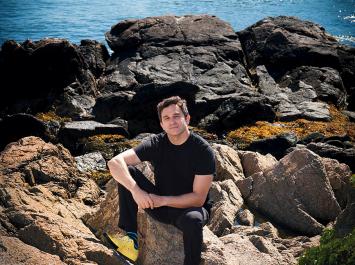Behind the Scenes: The Language of Whales
Managing editor Jonathan Shaw shares how he came to write about the research into decoding the language of sperm whales.
I was chatting with a colleague on a cold Friday morning in late January some years ago when he told me about an ambitious effort to decipher the vocalizations of sperm whales. Most cetaceans produce “whalesong,” but sperm whales click to communicate, producing patterns of clicks called codas. The idea that it might be possible to understand what the whales are saying formed at the Radcliffe Institute in 2017, when marine biologist David Gruber rubbed shoulders with a cryptographer and an expert in artificial intelligence, also there for a fellowship year. Speaking with another species? The idea seemed farfetched, but not impossible—in a word, intriguing.
Gruber had come to Harvard to work with professor of engineering Robert “Rob” Wood on developing soft robots for handling delicate marine life. But with this new project in view, their collaboration widened to include Harvard engineers and roboticists, linguists, computer scientists from MIT, and dozens of other experts from around the globe—all focused on collecting the millions of click vocalizations thought necessary for AI to decode sperm whale communications.
Steady reader support enabled me to follow this story as it developed during the last two years. I had the opportunity to speak with Rob and David many times, as Harvard engineers built the drones and suction cups and data collection “tags” that would attach temporarily to the whales. I met many of the talented researchers working in Wood’s microrobotics laboratory at the Science and Engineering Complex in Allston, and with professor Stephanie Gil and her students, who aim to eventually automate a drone-based data collection process. David, because he trusted the magazine as an institution, previewed the research papers that would be coming—and took me through the laboratory where the engineering was processing. To be able to follow a story like this one, which has unfolded across many years, requires great trust on the part of the researchers. And their willingness to provide Harvard Magazine with access tracks directly to the trust that readers place in us. For which I am always grateful.
Read “Decoding the Deep”

